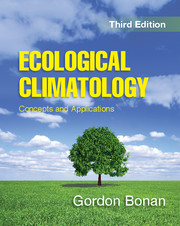Book contents
- Frontmatter
- Dedication
- Contents
- Preface
- 1 Ecosystems and Climate
- Part I The Earth System
- Part II Global Physical Climatology
- Part III Hydrometeorology
- 9 Soil Physics
- 10 Water Balance
- 11 Watershed Hydrology
- 12 Surface Energy Fluxes
- 13 Turbulent Fluxes
- 14 Soil Moisture and the Atmospheric Boundary Layer
- Part IV Biometeorology
- Part V Terrestrial Plant Ecology
- Part VI Terrestrial Forcings and Feedbacks
- Appendix
- Index
- Plate section
- References
12 - Surface Energy Fluxes
from Part III - Hydrometeorology
Published online by Cambridge University Press: 05 November 2015
- Frontmatter
- Dedication
- Contents
- Preface
- 1 Ecosystems and Climate
- Part I The Earth System
- Part II Global Physical Climatology
- Part III Hydrometeorology
- 9 Soil Physics
- 10 Water Balance
- 11 Watershed Hydrology
- 12 Surface Energy Fluxes
- 13 Turbulent Fluxes
- 14 Soil Moisture and the Atmospheric Boundary Layer
- Part IV Biometeorology
- Part V Terrestrial Plant Ecology
- Part VI Terrestrial Forcings and Feedbacks
- Appendix
- Index
- Plate section
- References
Summary
Chapter Summary
The energy balance at Earth's land surface requires that the energy gained from net radiation be balanced by the fluxes of sensible and latent heat to the atmosphere and the storage of heat in soil. These energy fluxes are a primary determinant of surface climate. The annual energy balance at the land surface varies geographically in relation to incoming solar radiation and soil water availability. Over land, annual evapotranspiration is highest in the tropics and generally decreases towards the poles. Geographic patterns of evapotranspiration are explained by Budyko's analysis of the control of evapotranspiration by net radiation and precipitation. Energy fluxes vary over the course of a day and throughout the year, also in relation to soil water availability and the diurnal and annual cycles of solar radiation. The various terms in the energy budget (net radiation, sensible heat flux, latent heat flux, and soil heat flux) are illustrated for different climate zones and for various vegetation types. The Penman–Monteith equation illustrates relationships among net radiation, latent heat flux, sensible heat flux, and surface temperature. Soil experiments that alter surface albedo, surface conductance to evapotranspiration, and thermal conductivity illustrate the importance of these properties in regulating surface temperature and energy fluxes.
Surface Energy Budget
The solar and longwave radiation that impinges on Earth's surface heats the surface. The surface reflects some of the incoming solar radiation and also emits outgoing longwave radiation. The remaining radiation is the net radiation at the surface. Net radiation is dissipated in three ways.
Movement of air transports heat in a process known as convection. A common example is the cooling effect of a breeze on a hot summer day. This heat exchange is called sensible heat. Greenhouse microclimates are an example of the warm temperatures that can arise in the absence of convective heat exchange (Avissar and Mahrer 1982; Mahrer et al. 1987; Oke 1987). It is generally thought that greenhouses provide a warm environment to grow plants because glass or other translucent coverings allow solar radiation to penetrate and warm the interior of the greenhouse while longwave radiation emitted by the interior surfaces is trapped within the greenhouse. Although this can happen, the daytime warmth in greenhouses is largely a result of negligible convective heat exchange with the outside environment. The sensible heat from the warm interior surfaces is trapped within the greenhouse, warming the interior air.
- Type
- Chapter
- Information
- Ecological ClimatologyConcepts and Applications, pp. 193 - 208Publisher: Cambridge University PressPrint publication year: 2015
References
- 3
- Cited by



